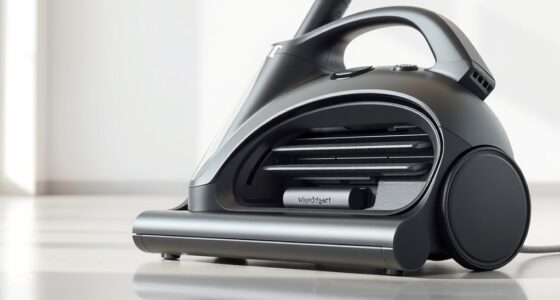Swappable battery packs are transforming electric mobility by allowing quick, seamless battery exchanges, reducing downtime and boosting convenience. Modular systems, like vacuums, could adopt this idea to improve efficiency and user experience. If you see potential in quick swaps for appliances or other devices, you’ll find that this innovative approach might shape the future of various portable technologies. Continue exploring to discover how modular designs could revolutionize more everyday tools beyond just EVs.
Key Takeaways
- Swappable batteries enable rapid, convenient power exchanges, similar to modular vacuums designed for quick cartridge swaps.
- Modular vacuum systems can benefit from swappable battery tech to enhance portability and reduce downtime.
- Both applications focus on standardization and automation to improve user experience and maintenance efficiency.
- Incorporating swappable batteries in vacuums promotes sustainability by allowing easy battery recycling and energy management.
- The success of swappable battery packs in EVs suggests potential for future modular designs in home and portable appliances like vacuums.

Have you ever wondered how electric vehicles could become more convenient and efficient? One promising solution lies in swappable battery packs, which could revolutionize the way we think about energy and mobility. Instead of waiting hours for a charge, you could simply swap out your depleted battery for a fully charged one at a designated station. This process, known as battery swapping, could drastically cut down downtime and make electric vehicles as quick to refuel as traditional gas-powered cars. The key to making this work smoothly is effective power management, ensuring that each battery swap is quick, safe, and seamless. By standardizing battery packs and creating an extensive network of swap stations, manufacturers can simplify maintenance, reduce costs, and improve user experience.
Swappable batteries can make electric vehicles as quick to refuel as gas cars through efficient power management and standardized stations.
Imagine you’re on a busy schedule, and your electric vehicle runs low on power. Instead of hunting for a charging station, you head to a swap station where a robotic arm or an automated system quickly exchanges your empty battery for a fully charged one. This process takes just a few minutes, comparable to filling up a gas tank. The advantage here is not only speed but also the ability to optimize power management by maintaining batteries at their peak performance levels. Swappable batteries can be regularly refreshed and balanced, reducing degradation and extending overall lifespan. This means you’re less likely to face unexpected breakdowns or performance dips, which can happen with traditional charging methods.
Moreover, battery swapping encourages a more sustainable approach to energy use. Stations can incorporate renewable energy sources like solar or wind to charge spare batteries, making the entire process cleaner. Since batteries are standardized, manufacturers can focus on improving battery technology in a centralized way, rather than designing unique solutions for each vehicle. This standardization also simplifies logistics and inventory management at swap stations, ensuring the right battery types are always available when needed. Power management becomes essential here, as systems need to monitor battery health, charge levels, and safety parameters in real-time, preventing issues like overheating or overcharging. Additionally, integrating natural farming techniques into the manufacturing and recycling processes of batteries can promote environmental sustainability and resource efficiency.
In the broader picture, swappable battery packs could help accelerate the transition to electric mobility by addressing one of its biggest hurdles: charging time. With smart power management and efficient battery swapping infrastructure, electric vehicles could become even more practical and appealing for daily use. This approach not only enhances convenience but also promotes sustainability and technological innovation, paving the way for a future where modular, swappable batteries become the norm rather than the exception.
Frequently Asked Questions
How Long Does a Typical Swappable Battery Last?
A typical swappable battery lasts around 2 to 3 years, depending on usage and charging cycles. You might notice the battery’s lifespan decreases with frequent charging, usually after about 300 to 500 cycles. To maximize its longevity, avoid overcharging or letting it fully drain regularly. Swappable batteries give you convenience, but remember that their overall battery lifespan is influenced by how often and how well you care for them.
Are Modular Vacuums Compatible With All Brands?
You might wonder if modular vacuums are compatible with all brands. Generally, brand compatibility varies, as some manufacturers design their modular systems to work only with specific brands, ensuring proper accessory integration. To avoid issues, always check the manufacturer’s specifications for compatibility. Keep in mind that choosing a versatile, widely compatible model can make it easier to upgrade or replace parts without worrying about limited accessory integration.
What Is the Cost Difference Between Traditional and Modular Vacuums?
Think of the cost difference as a balancing act, where traditional vacuums often seem like a fixed price tag, while modular models offer flexibility. In a pricing comparison, modular vacuums may initially cost more but save you money long-term with swappable parts. An affordability analysis shows that, although pricier upfront, their adaptability and durability can make them more economical over time. You gain value through versatility and extended use.
How Eco-Friendly Are Swappable Battery Packs?
You might wonder how eco-friendly swappable battery packs are. They help reduce waste by extending the lifespan of batteries and allowing replacements instead of entire units. However, recycling challenges and battery disposal remain concerns, as improper disposal can harm the environment. By choosing brands with responsible recycling programs, you can minimize negative impacts and make smarter, more eco-conscious choices when using modular vacuums.
Can You Upgrade Batteries Without Replacing the Entire Vacuum?
You can upgrade your vacuum’s battery without replacing the entire device, but it depends on compatibility. Some models allow easy battery upgrades, avoiding compatibility issues. However, if the new battery isn’t designed for your vacuum, you might face compatibility issues, making the upgrade difficult or ineffective. Always check if the replacement battery is compatible with your vacuum model before attempting a battery upgrade to guarantee a smooth process.
Conclusion
Imagine a world where your vacuum’s battery is as easy to swap as changing a light bulb—no downtime, no hassle. That’s the promise of modular vacuums with swappable batteries. While traditional models leave you waiting, these innovations let you power through chores seamlessly, like flipping a switch. As technology advances, the future looks brighter, cleaner, and more efficient—where convenience is just a snap away, and your cleaning routine becomes effortless.









